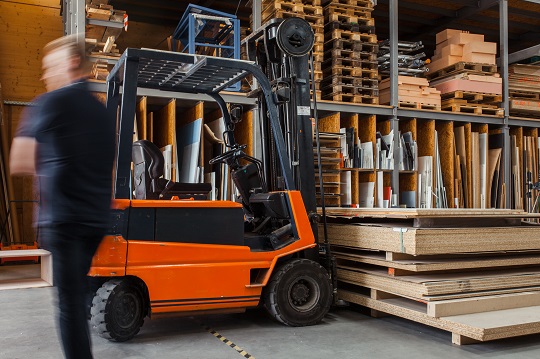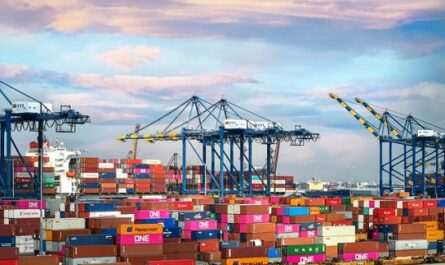When you work in a warehouse or factory, the process of moving goods and materials becomes one of the most important and continuous activities that you will carry out.
You can perform this activity in two ways: using human power (manual handling) or by using material handling equipment. Which one is better?
In this case, there is a debate between the use of manual handling and material handling equipment, regarding which is better in maintaining safety, efficiency, and productivity.
That is what we will discuss in this post, the differences between manual handling and material handling equipment, as well as their advantages and disadvantages, so that you can choose the best method for your warehouse or factory operations.
We will discuss the differences between manual handling and material handling equipment, as well as their advantages and disadvantages.
By doing so, you will be able to understand the benefits and risks associated with both methods in your warehouse or factory operations.
Furthermore, we will also talk about the knowledge and understanding of safe lifting techniques and methods, as well as the importance of considering safety when carrying out activities of moving goods and materials.
Therefore, you can make better decisions in choosing the most suitable method for your warehouse or factory operations, which ultimately can improve efficiency, productivity, and safety in the workplace.
But before we delve deeper, make sure you have joined the scmguide telegram channel to receive notifications of the latest posts from this blog as well as more insights on supply chain management.
Table of Contents
What are manual handling and material handling equipment?
Manual handling is the process of moving goods and materials using human power, such as lifting, moving, and stacking goods manually without using mechanical aids or machines.
On the other hand, material handling equipment refers to equipment or machines designed to assist in the efficient movement of goods and materials, such as forklifts, conveyors, pallet trucks, and cranes, for example.
Material handling equipment is designed to reduce physical labor and increase productivity by minimizing the risk of injury, fatigue, and material damage.
Why is it important to consider safety when lifting objects?
Considering safety when lifting objects is very important because lifting objects that are too heavy or not ergonomic can cause injury to the body, especially to the lower back, shoulders, and arms.
The most common conditions resulting from lifting heavy loads improperly are lower back injuries and muscle strains.
These injuries can cause pain, loss of work productivity, and even long-term work absences. You certainly don’t want that to happen, right?

Considering safety when lifting objects is also important to avoid damage to the transported goods. This will reduce the cost and time required to repair or replace damaged goods.
Considering these factors, it is important for companies and workers to consider safe techniques and methods for lifting objects, as well as reducing the risk of injury and damage to goods that may occur.
Advantages and Disadvantages of Manual Handling
Manual handling, or the handling of goods and materials using human labor, is a method that has been used for centuries in various human activities.
However, although it is still used in many places, manual handling is often seen as a riskier and less efficient method compared to the use of material handling equipment. Despite this, manual handling also has certain advantages that you need to consider.
What are they?
Let’s take a look.
Benefits of manual handling
Here are some of the advantages of manual handling:
- Lower cost: One of the main advantages of manual handling is its relatively lower cost compared to using material handling equipment. You do not need to spend money on buying or renting heavy equipment, as well as maintaining and repairing the equipment.
- Flexibility: Manual handling allows workers to move objects more flexibly and adapt to different situations. For example, when transporting objects from an area that is difficult to reach by heavy equipment.
- Space-saving: Heavy equipment often requires a large space to operate. In some cases, manual handling can be a more effective alternative to save space, especially in narrow spaces.
- Reducing the risk of damage to goods: In some situations, manual handling can be safer in moving objects and reduce the risk of damage that may occur when using heavy equipment.
- Reducing the risk of accidents: Manual handling allows workers to pay more attention and control their movements while carrying objects, so it can reduce the risk of accidents that may occur.
However, it is important to remember that manual handling also has risks and disadvantages that need to be considered.
Therefore, it is important to consider worker safety and health, as well as efficiency and productivity when choosing the best method for handling goods and materials in your warehouse or factory operations.
The disadvantages of manual handling
Now, let’s take a look at some of the disadvantages of manual handling. Here are some of them:
- Risk of injury: Manual handling increases the risk of injury to workers, especially if the load lifted is too heavy, the lifting technique is incorrect, or the lifting frequency is too high.
- Lower efficiency: Manual handling can be less efficient and take more time compared to using heavy equipment. This can affect productivity and operational efficiency.
- Need for proper training: Manual handling requires proper training to ensure that workers understand safe lifting techniques and methods. If not done correctly, it can increase the risk of injury to workers.
- Limitations on the weight of goods that can be lifted: In manual handling, the weight of goods that can be lifted is limited by the physical abilities of workers. This can limit your ability to move heavier or larger goods.
- Influence of environmental factors: Environmental factors such as weather, temperature, and surface conditions can affect the safety and health of workers when performing manual handling. For example, workers may be more vulnerable to injury when lifting loads in hot weather or unstable surface conditions.
Therefore, it is important to consider the risks and disadvantages of manual handling and take necessary preventive measures to minimize risks and ensure the health and safety of workers.
You might also like:
- Fast Logistics vs. Cheap Cost: Which One is More Important?
- The Importance of Business Process Mapping and How to Do It Effectively
How to reduce the risk of injury during manual handling
Manual handling or manual lifting can increase the risk of injury to muscles, spine, and joints. Here are some ways to reduce the risk of injury when doing manual handling:
- Use proper lifting techniques: Make sure you lift the load from the correct position by bending your waist and knees, and keeping your back straight during the lift.
- Use appropriate equipment: Use aids such as lifting bags or wheelchairs if possible. This will help reduce the risk of injury.
- Regular exercise: This will help strengthen your muscles and make you more flexible, making it easier to lift objects.
- Avoid lifting heavy loads: Make sure you only lift objects that you can safely carry. If the object is too heavy, use equipment or ask for help from others.
- Wear appropriate footwear: Wear the right shoes to avoid injury to your feet and back.
- Don’t rely on strength-based movements: Don’t rely too much on movements that require strength when lifting objects. It’s better to use movements that utilize momentum or rotation.
- Stretch before and after lifting: Do light stretching to warm up your muscles before manual handling, and stretch again afterwards to reduce muscle stiffness.
By following these tips, you can help reduce the risk of injury when doing manual handling. However, if you experience pain or discomfort after lifting, stop immediately and consult with a doctor or related expert.
Advantages and disadvantages of material handling equipment
Material handling equipment refers to tools and machinery used to move, lift, and manipulate goods and materials within production and logistics environments.
The use of material handling equipment can provide many benefits in terms of efficiency and productivity, but there are also some disadvantages that should be considered.
Let’s discuss each of these points so that you can decide whether or not the use of this equipment is suitable for your workplace.
The advantages of material handling equipment
The use of material handling equipment has many advantages, including:
- Increasing efficiency: Material handling equipment can help improve production and distribution efficiency. By using this equipment, the time and energy required to move materials can be reduced, which can increase production time.
- Reducing costs: Material handling equipment can help reduce production and distribution costs. By reducing the time and energy required to move materials, companies can save on labor costs and reduce overall operational costs.
- Improving quality: By using material handling equipment, the risk of material damage can be reduced. This equipment is designed to lift and move materials safely, so the risk of damage can be minimized.
- Reducing the risk of worker injuries: Material handling equipment can help reduce the risk of worker injuries. By using this equipment, workers do not need to lift or move materials manually, so the risk of injury can be reduced.
- Increasing flexibility: Material handling equipment can help increase flexibility in the production and distribution process. This equipment can be used to move various types of materials, including large or heavy materials.
The use of material handling equipment can bring many benefits to companies, such as increasing efficiency, reducing costs, improving quality, reducing the risk of worker injuries, and increasing flexibility.
The disadvantages of material handling equipment
While the use of material handling equipment has many benefits, there are also several disadvantages that should be considered, including:
- Investment costs: Material handling equipment can be very expensive, especially for larger and more sophisticated types of equipment. This can be a constraint for small or new companies that may not be able to afford such equipment.
- Maintenance costs: Material handling equipment requires high maintenance costs to keep it in optimal performance. Maintenance, repair, and replacement costs can be a burden for companies.
- Operator training: Operators need to be specially trained to operate sophisticated and large material handling equipment. This training can take additional time and cost for the company.
- Space limitations: Some types of material handling equipment require sufficient space to operate. If the space is limited, the use of this equipment can be difficult or even impossible.
- Dependence: Sometimes, companies can become too dependent on material handling equipment, so errors or failures in the equipment can cause production to stop or be delayed.
- Limited flexibility: Material handling equipment is generally designed to lift and move specific types of materials. If the type of material or product being lifted is different from what is usually operated, the equipment may not be able to handle it well.
The use of material handling equipment also has several disadvantages that should be considered, such as high investment and maintenance costs, operator training, space limitations, dependence, limited flexibility, and so on.
Therefore, companies must weigh the pros and cons of using this equipment before making a decision.
How to choose the right material handling equipment?
Choosing the right material handling equipment can be a challenging task for you.
However, by considering some important factors, you can select the right equipment for your company’s production and distribution needs.
Here are some factors that you should consider when choosing the right handling equipment:
- Type of material to be lifted and moved: First and foremost, it is important to consider the type of material or product that will be lifted and moved. This will determine the type of equipment that is most suitable for use.
- Weight and dimensions of materials: In addition to the type of material, the weight and dimensions of the material should also be considered when selecting the appropriate material handling equipment. Make sure the chosen equipment can handle loads that are appropriate for the weight and dimensions of the material.
- Work environment: The work environment also needs to be considered when choosing material handling equipment. For example, if the work environment is very dusty or there is a risk of explosion, then the chosen equipment must be designed to address these risks.
- Capacity and performance: The capacity and performance of the equipment should also be considered when choosing material handling equipment. Make sure the equipment you choose has adequate capacity and performance to meet the production and distribution needs of your company.
- Cost: Investment and maintenance costs should also be taken into account when choosing material handling equipment. Make sure the equipment you choose has an acceptable cost and provides value for the investment.
- Operator training: Make sure material handling equipment operators are well trained to operate the chosen equipment. This training is important to maintain equipment performance and minimize the risk of injury.
- Availability of spare parts and repairs: Make sure spare parts and repair services are available and easily accessible for the chosen equipment. This will help minimize production downtime if equipment experiences damage or problems.
By considering the above factors, you can choose the right material handling equipment to meet the production and distribution needs of your company.
Make sure the equipment you choose has good quality and performance and can provide long-term benefits for the company.
You might also like:
- Small Discrepancy in Stocktaking Results, Can It Be Ignored?
- Can Excess Inventory Benefit Your Business?
Factors that influence the decision
When it comes to lifting and moving materials or goods, there are two options to consider: manual handling and the use of material handling equipment.
However, in choosing between these two options, several factors need to be considered.
Let’s take a look at some of the important factors that you should consider in choosing between manual handling and the use of material handling equipment.
What are the factors that should be considered in choosing between manual handling and material handling equipment?
Some factors that need to be considered when choosing between manual handling and material handling equipment are:
- Type and amount of materials to be lifted and moved: The type and amount of materials to be lifted and moved can influence the choice between manual handling and material handling equipment. If the materials or goods are heavy and difficult to lift, then the use of material handling equipment may be a better option.
- Distance of movement: The distance that needs to be covered during the movement of materials or goods also needs to be considered. If the distance is far, then the use of material handling equipment such as forklifts or conveyors can speed up and simplify the movement.
- Availability of space: The availability of space in the workplace also influences the choice between manual handling and material handling equipment. If the space is limited, then manual handling may be a more suitable option.
- Cost: The cost of procurement and maintenance of equipment also needs to be considered. If the cost of procurement and maintenance of material handling equipment is too high, then manual handling may be a more economical option.
- Safety level: The safety level should also be considered when choosing between manual handling and material handling equipment. If there is a high risk of injury in manual handling, then the use of material handling equipment will be safer and reduce the risk of injury.
- Operator training and experience: Operator training and experience also need to be considered. If the operator does not have enough experience and training, then the use of material handling equipment can be a safer and more efficient option.
- Time efficiency and productivity: Time efficiency and work productivity should also be considered. If manual handling takes a long time and reduces productivity, then the use of material handling equipment can increase work efficiency and productivity.
In choosing between manual handling and material handling equipment, it is necessary to consider the above factors so that the choice made can maximize work efficiency and reduce the risk of injury to employees.
How to consider cost and efficiency when choosing between manual handling and material handling equipment?
Considering cost and efficiency in choosing between manual handling and material handling equipment is an important step for you to take.
Here are some things you can do to consider cost and efficiency:
- Calculate the total cost: Before deciding between manual handling and material handling equipment, calculate the total cost required. Total costs include procurement costs, operational costs, and maintenance costs. Then, compare the total costs of both options.
- Consider work efficiency: Work efficiency should also be considered. Material handling equipment can improve work efficiency and productivity, so total costs can be offset by increased revenue resulting from increased work efficiency. However, if material handling equipment is not necessary for significant work efficiency, then manual handling may be a more economical option.
- Measure processing time: The time required to perform tasks with manual handling and material handling equipment needs to be measured and compared. If material handling equipment can speed up processing time, then procurement and operational costs can be offset by increased work efficiency.
- Compare injury risks: The injury risks of manual handling need to be calculated and compared to the injury risks of using material handling equipment. If the injury risks of manual handling are higher, then using material handling equipment will be more cost-effective.
- Consider equipment lifespan: Equipment lifespan also needs to be considered in choosing between manual handling and material handling equipment. If material handling equipment can last long and require minimal maintenance costs, then total costs will be lower in the long term.
Considering cost and efficiency is an important step in choosing between manual handling and material handling equipment.
In considering both factors, careful calculation and evaluation are needed to make the right decision and be beneficial to the company.
Example case
Choosing between manual handling and material handling equipment is important in a company’s operational activities.
An example case can provide a real picture of this choice and its impact on the company.
The following case example will illustrate the choice between manual handling and material handling equipment in a manufacturing company to evaluate the factors that influence the choice and the cost and efficiency implications for the company.
In this case example, the steps taken to choose between the two options and evaluate the results will be discussed.
How the choice between manual handling or material handling equipment can affect productivity and safety in the workplace
A manufacturing company that produces large and heavy items is currently using manual handling to move raw materials from the warehouse to the production area.
However, the company has encountered several problems such as decreased productivity and an increased risk of injury to workers.
As a result, the company wants to consider the use of material handling equipment as an alternative to improve efficiency and reduce injury risks.

In considering the choice between manual handling and material handling equipment, the company conducted a case study by taking into account several factors such as cost, efficiency, injury risks, and their impact on productivity.
The first step taken was to calculate the total cost required for the procurement and operation of material handling equipment.
The company conducted research and compared several options such as forklifts, conveyors, and cranes.
After evaluation, the company decided to use forklifts as the material handling equipment because they were more suitable for moving large and heavy materials.
Next, the company compared the processing time between manual handling and the use of forklifts.
The result was that the use of forklifts could speed up processing time by up to 50%. In the long run, the use of forklifts could increase productivity and company revenue.
In addition, injury risks were also an important consideration in choosing between manual handling and material handling equipment.
By using forklifts, injury risks could be reduced because workers would no longer need to move large and heavy materials manually.
This could improve workplace safety and reduce costs resulting from worker injuries.
After considering all of these factors, the company decided to use forklifts as the material handling equipment.
The company invested in the procurement of forklifts and trained workers in their use.
As a result, the company experienced increased productivity and reduced injury risks to workers.
The choice between manual handling and material handling equipment can affect productivity and safety in the workplace.
Conducting a case study and considering the factors that influence the decision can help companies make the right and beneficial decision for the company and its workers.
You might also like:
- Why the Right Mindset is Needed in Supply Chain Management
- How to Treat KPIs the Right Way to Improve Your Supply Chain Performance
How certain companies choose between manual handling and material handling equipment
Here are examples of cases from several companies in choosing between manual handling and material handling equipment to move materials in their workplace:
- Company X. Company X is an electronics manufacturer and uses material handling equipment such as conveyors and pallet jacks to move production materials. This company chooses material handling equipment because it can improve efficiency and speed up processing time. Additionally, the use of material handling equipment also reduces the risk of injury to workers. Company X calculates costs and decides that the use of material handling equipment can result in long-term cost savings.
- Company Y. Company Y is a small manufacturing company and chooses to use manual handling to move production materials. This company chooses manual handling because it considers the cost of acquiring material handling equipment to be too high for a small company like theirs. However, Company Y still pays attention to the risk of injury to workers and provides training to minimize that risk.
- Company Z. Company Z is a food company and uses forklifts to move production materials from the warehouse to the production area. This company chooses material handling equipment because it can save processing time and improve efficiency. Additionally, the use of forklifts also helps to reduce the risk of injury to workers. Company Z evaluates costs and finds that investing in forklifts will provide cost savings in the long term.
- Company W. Company W is a heavy product manufacturer and chooses material handling equipment such as cranes and hoists to move production materials. This company chooses material handling equipment because it considers manual handling to be too heavy and risky for workers. Company W calculates costs and finds that the use of material handling equipment can result in long-term cost savings.
The choice between manual handling and material handling equipment can vary depending on the needs and characteristics of the company.
Several factors such as cost, efficiency, risk of injury, and the type of material being transported can influence a company’s decision in choosing between manual handling and material handling equipment.
In choosing between the two options, the company must carefully consider and evaluate the long-term costs and benefits.
Conclusion
In comparing manual handling and material handling equipment, we can draw some important conclusions.
First, manual handling has a higher risk of injury compared to material handling equipment.
Second, the use of material handling equipment can improve efficiency, productivity, and safety at work.
Third, the appropriate lifting method should be considered based on factors such as load, distance, and environmental conditions.
Current views on manual handling and material handling equipment are also essential to consider.
The increasing trend in the use of technology in material handling equipment, such as automation systems and robotics, shows the potential to increase efficiency and safety at work.
However, the importance of proper training and supervision must also be acknowledged to reduce the risk of injury associated with manual handling and material handling equipment.
Additionally, the use of advanced technology requires significant investment.
Therefore, the best recommendation for choosing between manual handling and material handling equipment is to prioritize safety at work.
Consider factors such as load, distance, and environmental conditions when choosing the most effective and efficient lifting method.
Pay attention to investment costs and necessary training before deciding to use advanced technology in material handling equipment.
By considering all these factors, companies can make the right decisions to ensure safety at work and improve overall productivity.
I hope this information is useful!
Please also share this article with your colleagues so that they can benefit from it as well. Join our scmguide telegram channel to receive notifications of the latest posts from this blog and gain more insights into supply chain management. All articles on this blog are free for you to use for any purpose, including commercial, without the need for attribution.

 by
by 

